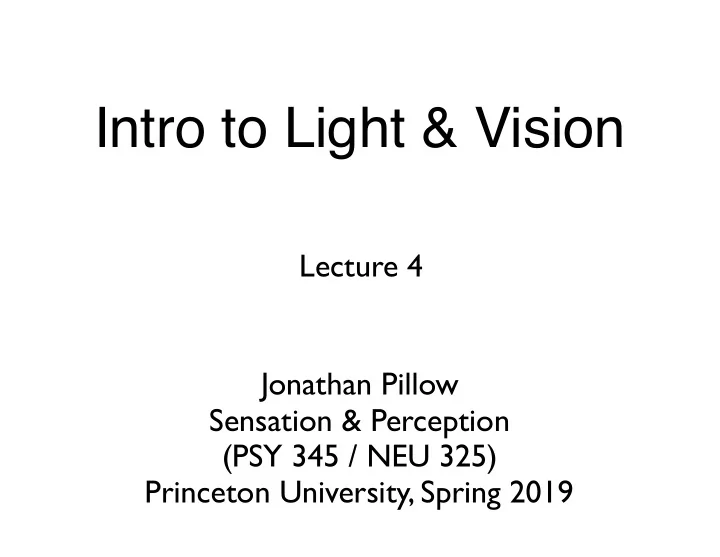

Intro to Light & Vision Lecture 4 Jonathan Pillow Sensation & Perception (PSY 345 / NEU 325) Princeton University, Spring 2019
Chapter 2: First steps in Vision
Light : electromagnetic radiation within a narrow energy range • a wave: can be bent by lenses • a particle: “photons” - can travel through a vacuum, have minimum energy that can be emitted/absorbed (quanta) • Light: A wave; a stream of photons, tiny particles that each consist of one quantum of energy
Food for thought : Why are we sensitive to such a narrow range of the electromagnetic spectrum? Other solutions are possible: • bees: ultraviolet light • pit vipers: infrared light
What happens to light? • Absorbed : Energy (e.g., light) that is taken up, and is not transmitted at all • Scattered : Energy that is dispersed in an irregular fashion (most light does this!)
What happens to light? • Refracted : Energy that is altered as it passes into another medium, (e.g., light entering water from the air) • Reflected : Energy that is redirected when it strikes a surface
Light Physics What it all looks like. (Messy!) • each point in space has light from all angles passing through it
Why do we need optics? • without optics, light from object screen everything hits the whole retina/screen/film • with optics, we form an pinhole camera image • i.e. light from a single point image in space hits a single spot on the retina
Pinhole camera: problem of pinhole size smaller aperture = fewer rays = sharper image = dimmer image
Some pinhole images why? big pinhole small pinhole tiny pinhole
diffraction • bending of waves around small obstacles or through small apertures slit = 1 x wavelength slit = 5 x wavelength
the eye (viewed from above)
• Cornea : The transparent “window” into the eyeball (carries 2/3 of eye’s total refractive power) • Aqueous humor : watery fluid in behind cornea • Lens : allows changing of focus • Pupil : The dark circular opening at the center of the iris in the eye, where light enters the eye • Vitreous humor : transparent fluid that fills main cavity of the eye (gel-like; may contain “floaters”) • Retina : light-sensitive membrane in the back of the eye that contains rods and cones.
• photic sneeze reflex tendency to sneeze when walking from a dark room into bright light topic of debate: • Aristotle - “sun heats the nose.” • Bacon - closed eyes and didn’t sneeze! • current thinking: “crossed wiring”
Image formation with a lens Goal is to focus the light rays emanating from a single point to a single point on the imaging surface
lenses converging diverging
Refraction: necessary to focus light rays, carried out by lens • Accommodation : process in which the lens changes its shape, altering its refractive power • Emmetropia : no refractive error
Refractive errors in vision (near-sightedness) (far-sightedness) • too fat / powerful • too thin / not enough accommodation • eye is too long • eye is too short
normal eye - accomodation min max far away object Good near object Good (courtesy ben backus)
normal eye - accomodation min max far away object Good near object Good (courtesy ben backus)
myopic (near-sighted) eye • lens too powerful min max can’t get far far away objects in object focus near object Good
myopic (near-sighted) eye • lens too powerful min max can’t get far far away objects in object focus near object Good
hyperopic (farsighted) eye • lens not powerful enough min max far away object Good near object
hyperopic (farsighted) eye • lens not powerful enough min max far away object Good can’t get near near objects in object focus
The precipitous drop in amplitude of accommodation with age
• Astigmatism : visual defect caused by the unequal curving of one or more of the refractive surfaces of the eye, usually the cornea • if you have an astigmatism, some lines will have lower contrast
Camera analogy for the eye • Aperture (F-stop) = Iris/pupil . Regulates the amount of light coming into the eye • Focus = Lens . Changes shape to change focus • Film = Retina . Records the image
Summary • light, electromagnetic spectrum, visible spectrum • light as a wave / particle • pinhole cameras, lenses, image formation, blur, diffraction, optics of the eye • anatomy of the eye (cornea, pupil, iris, aqueous, cilliary muscle, lens, vitreous, fovea, retina, and who could forget the Zonules of Zinn!) • accommodation, emmetropia, refractive errors (hyperopia, myopia, astigmatism)
the retina (“smart” film in your camera)
What does the retina do? 1. Transduction this is a major, • Conversion of energy from one form to another important (i.e., “light” into “electrical energy”) concept 2. Processing • Amplification of very weak signals (1-2 photons can be detected!) • Compression of image into more compact form so that information can be efficiently sent to the brain optic nerve = “bottleneck” analogy: jpeg compression of images
Recommend
More recommend